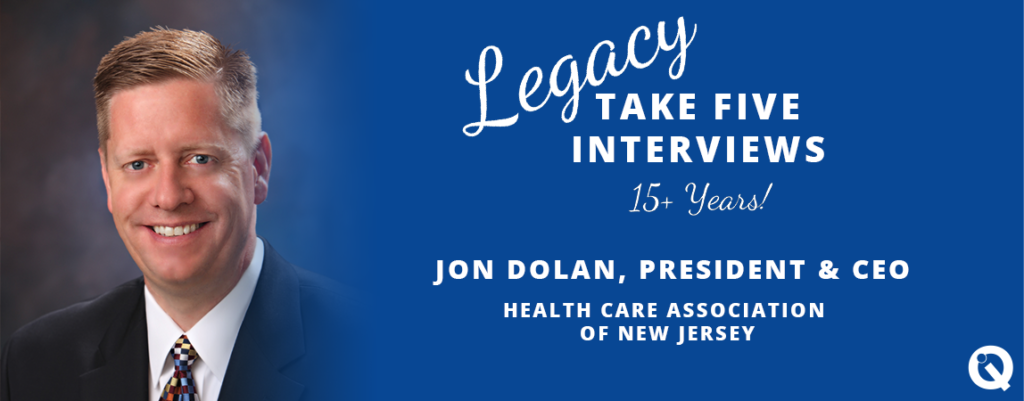This week’s newsletter includes our third Legacy Take Five interview. Throughout the year, we’ll interview some of our longstanding members who will share how their partnership with the Quality Institute helps them advance the mission we all share: improving the safety, quality, and affordability of health care for everyone.
Jon Dolan is President and CEO of the Health Care Association of New Jersey (HCANJ), which advocates for skilled nursing, assisted living, residential health, and adult day health service members. They have been a member of the Quality Institute since 2004.
How do you help your members achieve and measure quality?
For HCANJ and our national organization, the American Health Care Association (AHCA), quality is the priority. The focus comes through the leadership of our Director of Quality & Clinical Services, who advises, guides, trains, and leads our members to quality success. Loretta Kaes, RN B-C, C-AL, LNHA, CALA, is that leader for us and she is a dynamo. She advises our members about clinical operations and facility-based quality programs. Over the past few years, our team also promoted quality programs recently adopted by the state. The latest is a performance incentive based on five common metrics we promoted to the administration and the state Department of Human Services. Now, fully passed as part of the FY2020 budget, and if implemented as planned, it will result in a straightforward standard on five key metrics that will absolutely help our providers pursue and achieve quality.
As you look out at the next ten years — and as we see an aging population —what changes are the most innovative trends?
The move to person-centered care is nearly complete and remains a vital component. The facilities themselves are better and more homelike, and the progress on key metrics such as reducing off-label use of antipsychotic medications, fall prevention programs, and reduction in pressure ulcers is showing great progress. The most innovative trends involve using more current and even real time data and metrics to understand a resident’s condition and care needs — and improving a care delivery system. The baby boomers are totally different from the Greatest Generation and we have to respond.
Most people want to live independently for as long as possible. Is that an area where long-term facilities play a role?
We have a huge rehabilitation population and success in decreasing re-hospitalizations. We are sending more of our residents home to the independence they desire. However, we assume the most direct role for those whose complex medical care needs cannot be met at home or in independent living, such as those with advanced dementia…We become the best option. People say, “I don’t want to go into a nursing home.” But if you need one you should know that we are not the nursing homes of the past. There are saints and angels among us across the long term care continuum. I see that every time I visit my aunt who resides in a New Jersey facility. She stayed home as long as she could but ultimately needed and has found the right place for her now.
How do you envision technology impacting skilled nursing facilities?
Considering our place on the care continuum and the chronic underfunding of Medicaid, and with fewer private pay residents, we are behind in many areas and somewhat in technology. Despite these ongoing challenges, we have taken our place among other sectors and we’re increasingly utilizing and benefitting from technology. We are using assessment and care management software programs, medication administration systems, mobile diagnostic services, telemedicine, and electronic health records. And we’re using digital media to stay in touch with families. We see technology playing a bigger role in quality well into the coming “silver tsunami.”
How does your membership with the Quality Institute impact your work in quality and affordability?
The Quality Institute welcomes us as true partners — and that means so much since that is not always the case in every health care discussion or decision. Additionally, we are advocates for our providers and residents. Knowing that the Quality Institute is there with relevant programs and cutting-edge quality ideas, sets an example for us to emulate or participate in achieving. The issues of Medicaid reform, quality improvement, and population health and satisfaction are central to our mission —and to the Quality Institute as well. The Quality Institute’s Medicaid Blue Print for the Future, for instance, was very impactful.

